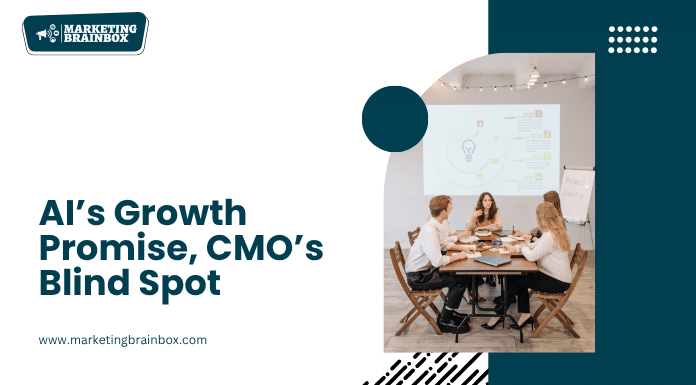There is an increasing number of cases of chief marketing officers (CMOs) faced with a severe bottleneck in their intense involvement in the grafting of artificial intelligence (AI) into their strategies: insufficient measurement tools and obscure ROI models. Although the use of AI is intensifying in the field of industries, there is an increasing disparity between ambition and responsibility, which has the potential of limiting the realization of its potential in marketing.
A survey of marketing leaders across the globe recently concluded that despite more than 70 percent of CMOs investing in the use of AI-powered applications, fewer than 30 percent of them feel confident with their chances of measuring how effectively those technologies are working.
Marketing and it is an endless AI Movement
The marketing universe has welcomed AI with open arms- including everything related to automating customer segmentation, a personalized campaign of email. Even the procedure of optimizing media buying. CMOs are being pressured to deliver growth, and it seems that AI holds the possibilities of speed, scale, and efficiency.
“AI is not a question of the future, but a competitive requirement in the present as stated by Lara McMillan, CMO at one global B2C brand. However, the utilities to demonstrate the worth of AI are yet to close the gap.
Use cases span:
- Predictive analytics
- Chatbots and virtual assistants
- Dynamic content generation
- Programmatic advertising
- Real-time customer insights
But as it is being implemented more and more many of these tools are being rolled out without the proper KPIs (key performance indicator) or set benchmarks.
The ROI Gap: Big Investment, Unclear Returns
Lack of Frameworks for Success
Majority of the marketing teams continue to apply obsolete measures- like the click-through rates, or the number of impressions- to analyze AI-based campaigns. Such measurements may not represent a deep and profound use of AI from a metric point of view in the form of customer retention, lifetime value or revenue accreditation.
Moreover, artificial intelligence systems in general and machine learning systems in particular may operate in black box mode. Marketing teams may not infrequently not be capable of saying how or why AI ended up at a specific recommendation or conclusion.
“That is how one senior digital marketing lead explained it, saying: we do know that it is working somehow, but we cannot really capture the way how in a clear manner. This is an issue when you have to defend budget or maximize strategies.”
Measurement Challenges Slowing Momentum
Problems of AI measurement that CMOs are facing may be divided into the following areas:
- Lack of Standardized Metrics
This basically makes comparison of campaigns and holistic reporting unnecessary. The following are the most critical of them:
- Opaque Algorithms
Most AI platforms lack transparency in terms of their operation. This induces a situation of accountability and trust problems, especially in regulated sectors such as in finance or even the healthcare industry.
- Data Quality and Integration
The only good AI systems are those that get fed good data. The marketing teams can also not be relied upon to be any better at eking out insights than Pauka, being technically unsophisticated and thus underutilized or misinterpreted.
- Skills Gap
To ensure that they overcome experimentation and pilot schemes, CMOs will be required to demand a better quality of analytics and models of governance when they choose AI providers.
AI’s Promise Requires Better Analytics
To move beyond experimentation and pilot programs, CMOs must demand better analytics and governance frameworks from AI vendors. Key steps include:
- Building custom attribution models tailored to AI-influenced campaigns
- Integrating AI platforms with existing data lakes and CRMs
- Training marketing teams on AI literacy and interpretation
- Co-developing KPIs in partnership with data science and IT teams
- Auditing algorithmic decision-making for fairness, bias, and exploitability
It is time to create industry-wide standards against which the effectiveness of AI in marketing can be measured, not simply the speed or level of automation, but the bottom line success or failure of a business.
Forward-Thinking CMOs Are Reframing the Narrative
Certain sets of marketing executives are already transforming the meaning attached to success. Instead of targeting only the vanity metrics, they are considering options of long-term value creation by use of AI based personalization, orchestration of customer journeys, and prediction of behavior.
“Nathan Reyes, CMO at a SaaS startup, explained that it is all about making the marketer even more influential. To show that impact, we have to be smarter and get better tools.”
The pioneer companies are also considering the governance of AI councils, cross-functional groups of tech, marketing, and legal stakeholders who assess AI tools prior to their complete implementation.
The Bottom Line
AI is an opportunity of a kind of revolution of CMOs, it offers a chance to go beyond reactive marketing and shift to predictive and personalized marketing. Devoid of powerful methodologies of quantification, however, such innovations can turn into costly experiments when they should be dependable growth vehicles.
Marketers need to demonstrate and clearly illustrate how AI will result in a better ROI to induce spend until that happens, investment will continue to be a concern and its potential will go underutilized.

